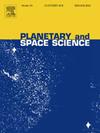Mercury's early thermal evolution and core formation in the presence of impact-generated atmosphere during accretion
IF 1.7
4区 物理与天体物理
Q3 ASTRONOMY & ASTROPHYSICS
引用次数: 0
Abstract
Understanding a planet's early thermal evolution and differentiation is crucial to comprehending the distribution of volatiles in its different reservoirs. Mercury is now known as a volatile rich planet. It has carbon saturated core, deeply buried volatile rich layers, a diamond layer at the core-mantle boundary and graphite floating at the crust. For carbon saturation, Mercury is believed to have accreted from Enstatite/CB chondrite rich building blocks. In the present work, we studied the early thermal evolution and core formation in the interior of Mercury by considering its accretion from water rich Enstatite chondrites prior to the dispersal of solar nebula. The heat sources for the melting and differentiation of Mercury include the decay energy of SLR 26Al and the blanketing effect of the impact generated H2O+CO+H2 along with primordial atmosphere. The results suggest the complete core formation with lowest assumed water content in the building blocks Mercury for accretion timescales ≤1.5 Myr after the formation of CAIs. The longer accretion timescales, it needed higher abundance of water to cause significant blanketing effect at the surface. During differentiation process, the volatiles dissolved in the magma ocean under the pressure of overlying atmosphere, could partition into the core. Hence, the outcomes of present study have implications to explain the distribution of volatile in the interior of Mercury. Conversely, under the strong blanketing effect, the surface silicate could vaporize and dissolve in the steam atmosphere.
水星早期的热演化和核心的形成,在吸积过程中有撞击产生的大气存在
了解一颗行星的早期热演化和分化对于理解其不同储层中挥发物的分布至关重要。水星现在被认为是一颗挥发性丰富的行星。它有碳饱和的地核,深埋的富含挥发性物质的地层,在地核-地幔交界处有一层金刚石层,在地壳处漂浮着石墨。对于碳饱和度,水星被认为是从顽辉石/CB球粒陨石丰富的构建块中吸收的。在本研究中,我们考虑了水星在太阳星云扩散之前由富含水的顽辉石球粒陨石吸积而成,研究了水星内部的早期热演化和核心形成。汞熔化和分化的热源包括SLR 26Al的衰变能和H2O+CO+H2随原始大气撞击产生的覆盖效应。结果表明,在cai形成后,在吸积时间尺度≤1.5 Myr时,构建块体汞中假定含水量最低的完整岩心形成。吸积时间尺度越长,需要的水丰度越高,地表才会产生明显的覆盖效应。在分异过程中,岩浆海中溶解的挥发物在上覆大气压力的作用下,可以分裂到地核中。因此,本研究的结果对解释水星内部挥发物的分布具有重要意义。相反,在强烈的覆盖作用下,表面硅酸盐在蒸汽大气中蒸发溶解。
本文章由计算机程序翻译,如有差异,请以英文原文为准。
求助全文
约1分钟内获得全文
求助全文
来源期刊

Planetary and Space Science
地学天文-天文与天体物理
CiteScore
5.40
自引率
4.20%
发文量
126
审稿时长
15 weeks
期刊介绍:
Planetary and Space Science publishes original articles as well as short communications (letters). Ground-based and space-borne instrumentation and laboratory simulation of solar system processes are included. The following fields of planetary and solar system research are covered:
• Celestial mechanics, including dynamical evolution of the solar system, gravitational captures and resonances, relativistic effects, tracking and dynamics
• Cosmochemistry and origin, including all aspects of the formation and initial physical and chemical evolution of the solar system
• Terrestrial planets and satellites, including the physics of the interiors, geology and morphology of the surfaces, tectonics, mineralogy and dating
• Outer planets and satellites, including formation and evolution, remote sensing at all wavelengths and in situ measurements
• Planetary atmospheres, including formation and evolution, circulation and meteorology, boundary layers, remote sensing and laboratory simulation
• Planetary magnetospheres and ionospheres, including origin of magnetic fields, magnetospheric plasma and radiation belts, and their interaction with the sun, the solar wind and satellites
• Small bodies, dust and rings, including asteroids, comets and zodiacal light and their interaction with the solar radiation and the solar wind
• Exobiology, including origin of life, detection of planetary ecosystems and pre-biological phenomena in the solar system and laboratory simulations
• Extrasolar systems, including the detection and/or the detectability of exoplanets and planetary systems, their formation and evolution, the physical and chemical properties of the exoplanets
• History of planetary and space research
 求助内容:
求助内容: 应助结果提醒方式:
应助结果提醒方式:


